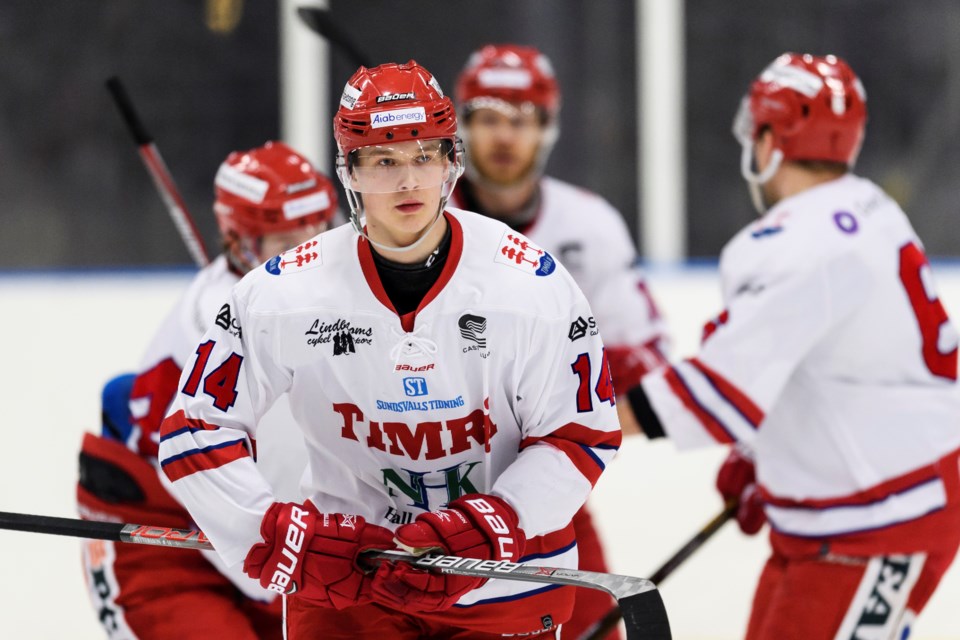Jim Benning seems committed to picking either a centre or an offensive defenceman with the fifth overall pick. If he’s going to pick a centre, the most common names that have come up are Gabe Vilardi, Casey Mittelstadt, and Cody Glass.
But there’s another player that has gone somewhat under the radar that might be the Canucks best option for finding a first-line centre: Elias Pettersson.
It’s been fascinating looking at different rankings for this year’s draft. Nolan Patrick and Nico Hischier are (almost) always the top-two, but there are massive differences of opinion for the rest of the first round.
This is reflected in Pettersson’s position in the various draft rankings. He ranges anywhere from 5th (HockeyProspect.com) to 27th (Sportsnet’s Jeff Marek) on some of the more well-known lists. International Scouting Services has him at 20th, Craig Button at 12th, and Bob McKenzie at 11th, as does McKeen’s Hockey.
You’ll notice that the vast majority rank him below fifth overall, where the Canucks pick. So why should the Canucks be interested in him?
There are some rankings that are very high on Pettersson. Central Scouting Services ranks him as the second best European skater in the draft, behind the controversial Klim Kostin. For those who favour analytics in their drafting, Scouching ranks him third overall. So does prospects writer Zachary Devine.
It’s not hard to see why he’s rated so highly. Pettersson tore up the Allsvenskan this past season, putting up just short of a point per game. His 41 points in 43 games for Timrå IK was good enough for 9th in league scoring. The only U-20 player who scored more was his teammate and new Canucks prospect Jonathan Dahlen, who is a year older. The next best teenager had just 24 points.
That type of production for a teenager against men is undeniably impressive. Not even William Nylander and Filip Forsberg produced at that rate in the Allsvenskan as teenagers.
Scouching points out that Pettersson had a goal or first assist on 60% of Timra’s even-strength goals, which compares favourably to Nolan Patrick, Nico Hischier, Gabe Vilardi, and Casey Mittelstadt, all of whom were playing in junior leagues instead of with and against men.
When you watch Pettersson play, his skill is undeniable.
From watching him and from reading a wide range of scouting reports, it’s clear that his game is multifacted. He’s an efficient skater, who somehow never looks explosive or blazingly fast, but doesn’t get beat to pucks and can create separation on breakaways.
He has sublime hands, controlling the puck well in traffic and occasionally making defenders and goaltenders look silly. On top of that, he can beat a goaltender with either his wristshot or his slap shot, both of which are heavy and accurate. But he projects as more of a playmaker than a goalscorer, with his excellent vision, decision-making, and passing.
His best asset, however, is his intelligence. His former coach, Roger Forsberg, said, “his biggest gift is that he has an incredible understanding of the game. He sees the game from every angle and he is ahead of you all the time, so he always knows what to do with the puck. He finds solutions in the offensive zone that only he can see.”
And reports suggest that his hockey iq and determination manifest in more than just the offensive zone, as he is diligent defensively, pursuing the puck with the same vigor as he drives to the net.
So what’s the issue here? His production in the Allsvenskan league combined with the clear first-line upside of his skillset suggests that he should be right behind Nolan Patrick and Nico Hischier or, at the very least, in the top-5.
There are two big question marks when it comes to Pettersson: his size and his international performance.
Pettersson isn’t short at 6’2”, but he’s very lanky and lacks lower-body strength. He weighs around 160 lbs, depending on which site you look at, and scouts all seem to agree that his lack of lower-body strength will be an issue on the smaller ice surface in the NHL.
The smaller ice surface certainly seemed to be an issue when he played at the World Junior Championships, which were played in Canada. He had high expectations heading into the tournament and fell well short, managing just one point, an assist, in six games.
The thing is, Pettersson didn’t exactly play poorly; he just seemed to be snakebit. That’s little consolation for those who place a premium on seeing prospects perform against their peers in international play.
You could also see his slight frame as a plus, knowing that he has a lot of room to grow. If he can get stronger, he could be more than just a first-line centre; he could be a franchise forward and a future star, which is how a Swedish scout described him to Corey Pronman.
But there’s still that uncertainty and the knowledge that he’s likely 2-3 years from making the NHL. That shouldn’t bother the Canucks, who are several years away from contending, but Jim Benning and co. might not be so patient. But drafting someone as dynamic and skilled as Pettersson could be incredibly exciting for the fanbase.
The fact that the Canucks already have Dahlen, who Pettersson has described as his “best friend,” might suggest that the Canucks could be interested in Pettersson as well. There’s just something very right about a Swedish centre and left wing who played together in Sweden coming to Vancouver to take over from the Sedins.



